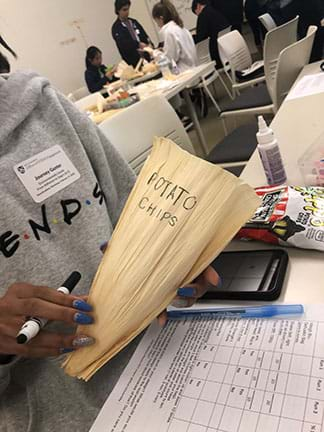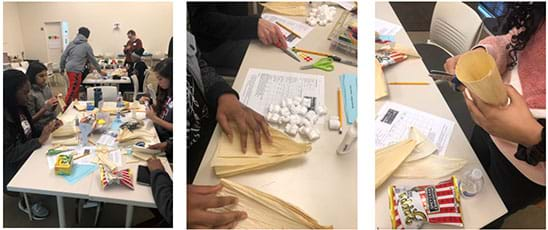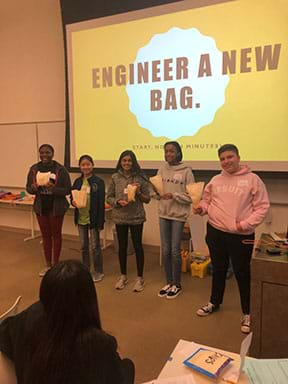Quick Look
Grade Level: High school
Time Required: 2 hours (wild guess!)
Subject Areas: Biology, Chemistry, Science and Technology

Maker Challenge Recap
This activity allows students to engage in design thinking that focuses on engineering a biodegradable bag for potato chips. In doing so, students move through the engineering design process. Students focus on design qualities such as if the bag retains moisture, how the bag is sealed, package aesthetics, and its shelf life. Students must meet the design criteria by using a rubric to guide their plans. The edges of bag must be sealed, and the entire bag must pass a quality control inspection (the shake, drop, toss, and moisture test). In addition, the bag must be aesthetically pleasing to the customer’s eye.
Maker Materials & Supplies
- 8 ears of corn with husk and silk, or dried corn husks
- large bag of potato chips (can be an empty bag)
- waterproof wood and/or plastic glue; (students can make their own glue too; see Teacher Notes for more information)
- edible glue
- small bowl filled with potato chips or small wood chips
- plastic bin with water (filled enough to submerge the prototype bag)
- golf balls (at least six)
- meter sticks
- heat lamp
- digital scale
- Biodegradable Husk-Bag Student Worksheet (one per student)
- Consumer Survey (optional)
Worksheets and Attachments
Visit [www.teachengineering.org/makerchallenges/view/rice-2505-bio-husk-bags-design-challenge] to print or download.Subscribe
Get the inside scoop on all things TeachEngineering such as new site features, curriculum updates, video releases, and more by signing up for our newsletter!More Curriculum Like This

Students act as industrial engineers, conducting tests to compare different plastics and performing a cost-benefit analysis to determine which are the most cost-effective for a given application, based on their costs and measured physical properties.

The Great Pacific Garbage Patch (GPGP) is an intriguing and publicized environmental problem. Through exploring this complex issue, students gain insight into aspects of chemistry, oceanography, fluids, environmental science, life science and even international policy.
Kickoff
Snack bags, such as potato chip bags, are made up of several layers of polymers. These include one called biaxially orientated polypropylene, which the polymer that gives a bag a thin, film-like feel. Low density polypropylene, or LDPE, which is commonly used in all plastic materials, and an outer layer of thermoplastic resin. In other words, all these polymers are non-biodegradable plastics that are not easily recycled. Most end up in landfills, or worse, in our oceans and waterways. To illustrate this, show students the following video on non-degradable plastics to capture their attention to a real-life issue Plastic Pollutants Video. This video is also available on slide 6 of the PowerPoint Presentation, which you can also show to students in preparation for this challenge. You may also print out copies of the Six-Panel Storyboard to distribute.
Resources
Consider having students research non-degradable plastics as well as biodegradable materials so they can form ideas and use this knowledge to go about designing their prototype. Refer to the Teacher Notes on how to use the materials and perform the quality control tests.
Refer to the Engineering Design Process hub on TeachEngineering to guide your students through the challenge. If documentation of the design process is desired, utilize the Engineering Design Process Notebook.
Maker Time
Ask students to work in groups of four to compare and contrast non-biodegradable and biodegradable substances. Have students take some time to write down ideas that might help eliminate the excess of non-biodegradable trash and have the groups share. Ask students to think of a great product they could use to design a potato chip bag that does not create excess waste. What type of products would they need?


Wrap Up
Students will compare, brainstorm, and reflect one group at a time by answering the following questions:
- What worked and what did not work when you tested your engineered design?
- What changes would you make to improve your design?
- What grade did your product make based on the quality control rubric?
- Which group scored the highest on the quality control test?
- What other products can you make from corn husk?
- How can you apply this lesson to the real world?
- (Optional) What did your consumers say? [Have students complete the Consumer Survey on each other’s’ designs and discuss the survey responses.]
Other
- Students can think of other products that they can make, such as the non-plastic water bottle.
- Students can write the answers to the Wrap-Up questions on a poster and present it to the class.
Copyright
© 2020 by Regents of the University of Colorado; original © 2019 Rice UniversityContributors
Melissa M. Mason, Developer; Alphonso A. Causey, Jr, Tester and ContributorSupporting Program
Research Experience for Teachers (RET) , Rice UniversityAcknowledgements
This material was developed in collaboration with Rice University Office of STEM Engagement, based upon work supported by the National Science Foundation under grant no. NSF 1711515--the Nanotechnology Research Experience for Teachers at the Rice University School Science and Technology in Houston, TX. Any opinions, findings and conclusions or recommendations expressed in this material are those of the author(s) and do not necessarily reflect the views of the National Science Foundation or Rice University.
Thank you Nanotechnology Research Experience for Teachers at Rice University School of Science and Technology in Houston, Texas for an amazing experience and for introducing Teachengineering.org.
Special thanks to Isaias Cerda for being a guiding light that helped navigation through such a remarkable program, Research Experience for Teachers.
Last modified: July 27, 2020







User Comments & Tips